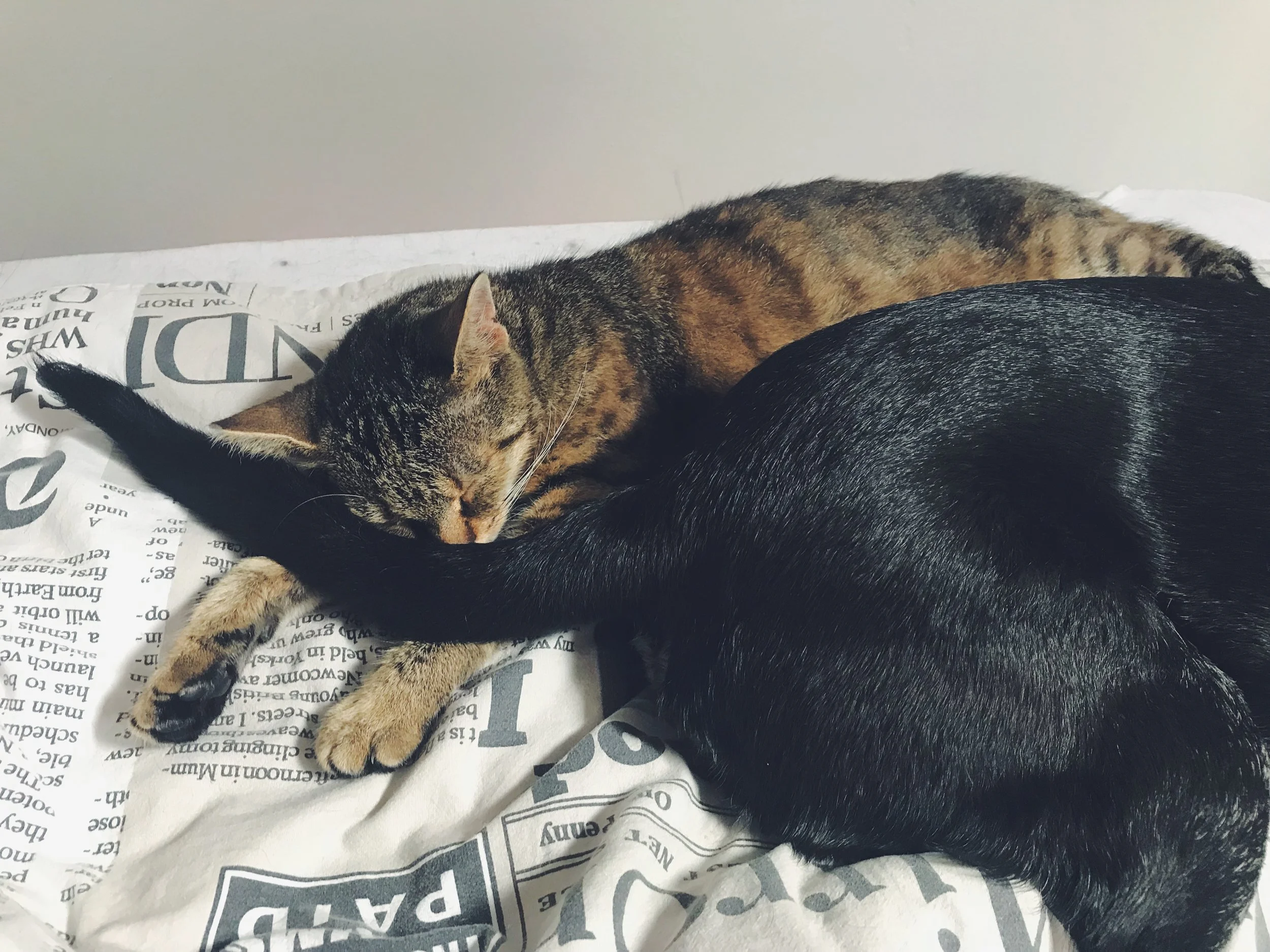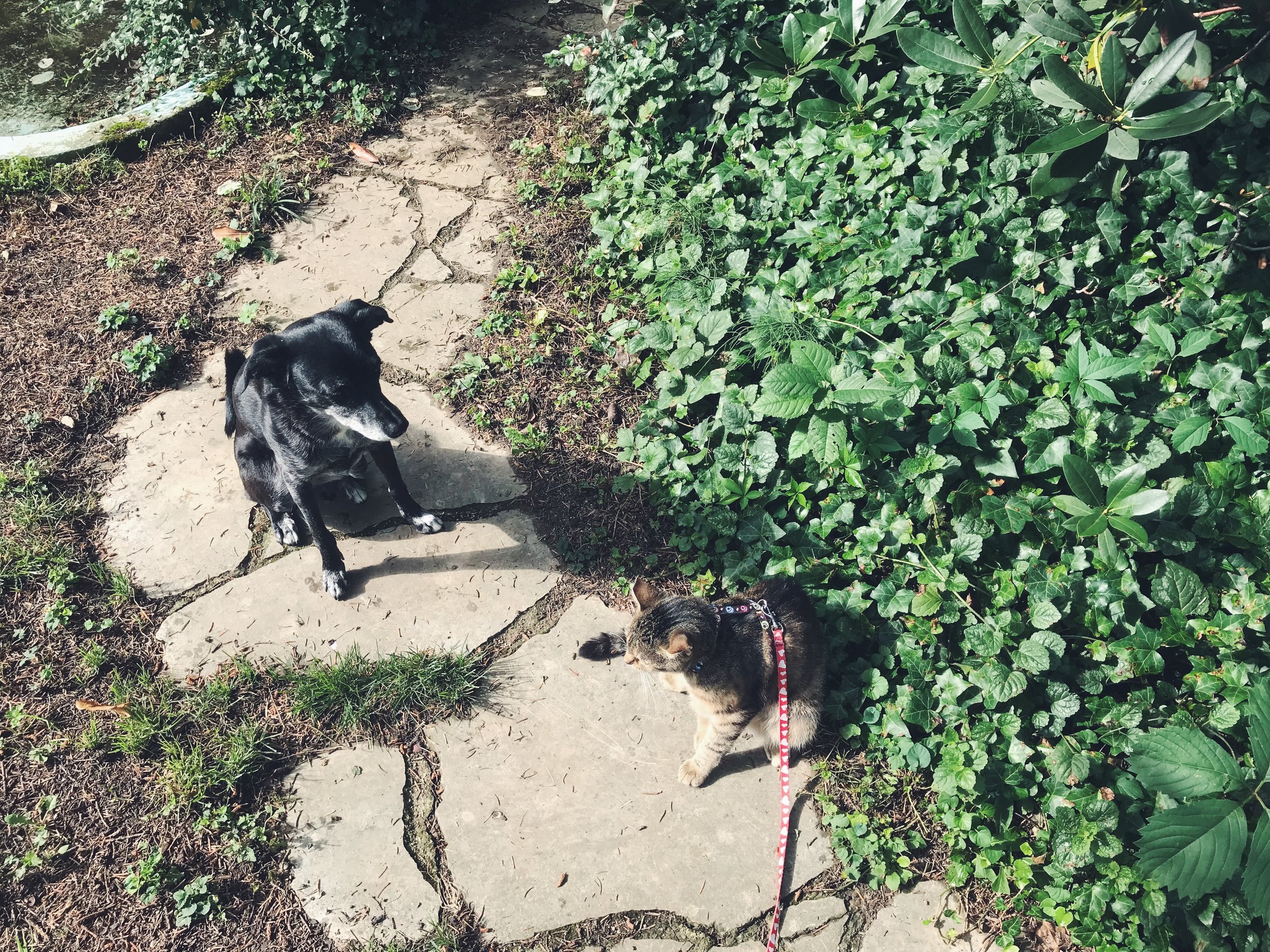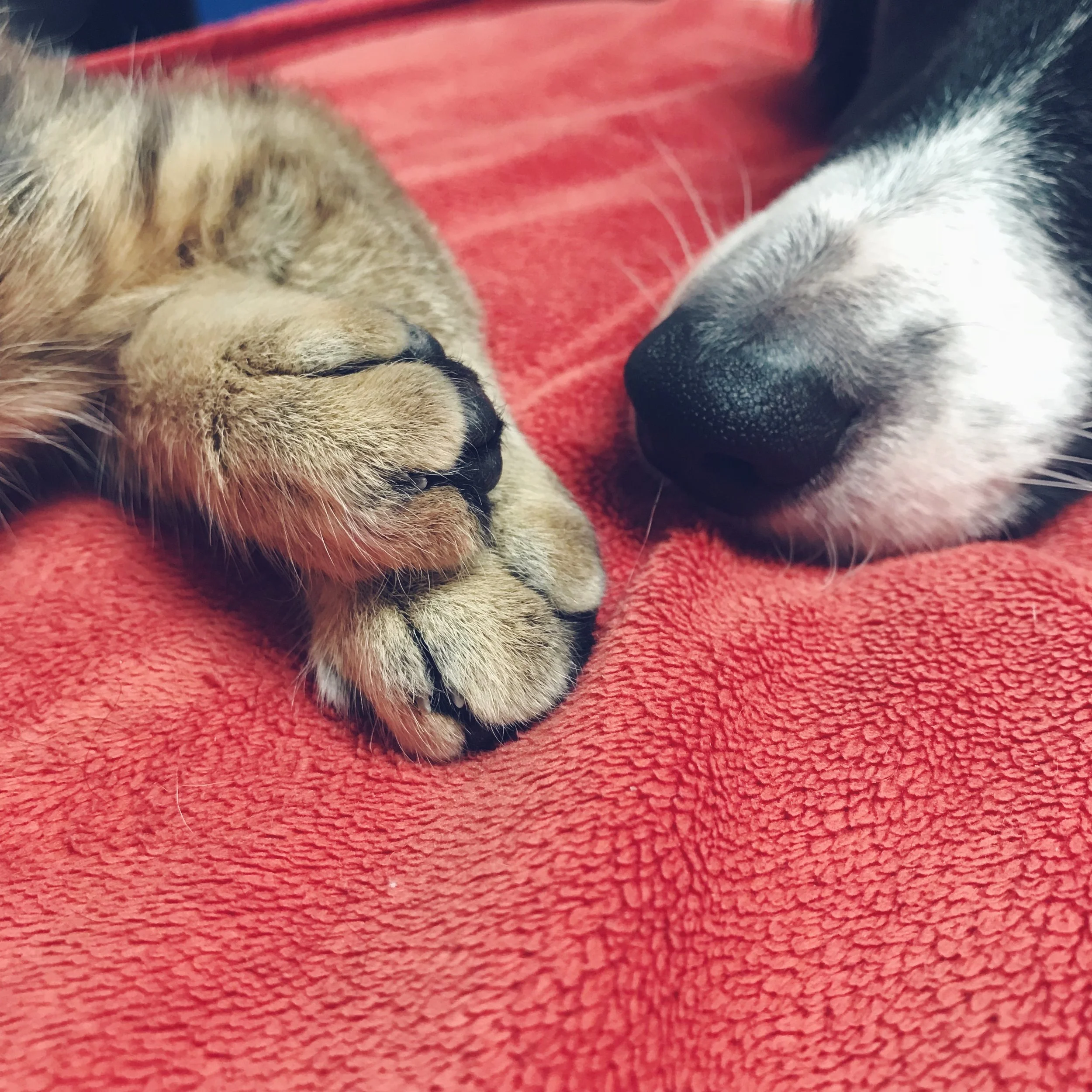Reactive Dogs and Cats: A Socialization Guide [Part 2]
/Welcome to Part 2 of a socialization guide that is going to teach you how to peacefully live with both cats and dogs - especially if you have reactive dogs (or ones with a high prey instinct). If you haven’t read Part 1 of this series yet, please do so! You can find it right here! That’s where I explained why it’s so important to start this process of socialization outside of the house. There are detailed step by step instructions on how to make sure your dog and cat both feel safe, how positive reinforcement is at the center of this process and how cultivating patience is perhaps the most important part of it all.
If you’ve read all of that already and have been working outside of your home to the best of your abilities to bring your pooch and kitten together, now is when we move into the more sensitive territory: the indoor living space.
Shadow was not adopted from a shelter; she just climbed onto my balcony and chose my as her human. She literally didn’t want to leave. I fed her, I took her to the vet, I took care of her and then expected her to leave and roam around. But she never did; she just stayed. In the first two months of her being with us, she was an indoor/outdoor cat. I am fully transparent when I tell you that I had no idea how to mother a cat and even less knowledge about cat behavior, stray cat problematic etc. I got a lot of bad advice in those first two months and I learned from my mistakes. One day Shadow suddenly became seriously ill and became an indoor cat practically overnight. Meaning, my dogs needed to learn how to share a living space with Shadow overnight. We did a lot of our outdoor work by then, so they definitely knew Shadow and were used to her. But sharing a living space comes with a lot of challenges, especially if you have a reactive dog. We had our ups and downs but in the long run they are worth it if I can help other people through our experiences. This blog post will hopefully help you brave the first few weeks and months of cohabiting with canines and felines! 🐱
PERSONAL SPACE
Everyone in your furry family is going to need some personal space in the first few weeks. I’m serious about this - I’ve heard of people returning their cats and dogs back to the shelter after only a few days. If you are not capable of patience that is going to have to be cultivated for weeks (or months or perhaps a lifetime, depending on your dog’s reactivity), then don’t get a cat. It’s not fair to bring an animal home and then not stick with them through thick and thin!
If you have a reactive dog, you already know they need a lot of personal space, to rest and decompress. This is something that will probably never change and the more we help them by giving them safe spaces, the more relaxed they are going to feel within your home and around new additions. Your reactive dog must always know that he has a place to retreat to. He should never feel trapped in a situation or without an option to exit it. This is very important when socializing your dog to other creatures, especially one that is of a different species. Some reactive dogs can clearly read the body language of another dog, but cats might be a bigger mystery to them. The safer they feel, the less likely they’ll be to lash out.
On the other hand, your kitten is going to need some personal space as well. This depends on their personality very much, so be mindful of that and pay attention to what your cat is asking for. My Shadow absolutely adores the dogs and she was never afraid of them, but Chilly is too much of an attention seeker even for her and it took a while for him to understand that she won’t play with him just yet (or at all). If your cat is pawing or hissing at the dogs, don’t let them “hash it out themselves.” This is just plain stupid, I’m sorry. You’ll end up with animals who don’t trust you to create safety for everyone involved and they might have serious arguments amongst each other, leading to one or more of your animals being hurt. A cat can seriously, seriously injure your dog! You should never allow your cat to harass your dog in any way, either. The videos that people post on Facebook of how afraid dogs are of cats are incredibly harmful and perpetuate the idea that cats are aggressive creatures who want to dominate dogs. The truth is that there is no cross-species domination and that happy cats are not aggressive cats! If your cat feels the need to lash out at your dog it’s because she does not feel safe - and making her feel safe is YOUR responsibility!
Here are a few ideas on how you can make sure everyone has their own personal space:
1. Crate training: both of my dogs and my cat are crate trained. I can’t stress enough how much this helped. I put all three of them each in their own crate and they could all see each other but were safely confined to their safe space. Sometimes I would let one of the dogs out and allowed them to sniff Shadow through the crate, if they wanted. I did the same with Shadow. I kept the two dogs in their crates and allowed Shadow to roam around the room. This was very helpful especially for Bailey, because she could safely observe the cat. I also paid attention to anything that triggered her. For example, she was totally fine if Shadow was walking up and down the room, but if she came too close to Bailey’s crate or if she jumped on something above the ground, Bailey would bark. This was important for me to know, so that I could immediately start desensitizing her to these triggers.
2. Leashes: Chilly is a typical bubbly border collie and he didn’t understand that Shadow just won’t play with him. He would try to hoax her into playing by barking at her from close proximity (that was his herding instinct kicking in), trying to get her to run away so he could chase. Sometimes he would even try to paw at her but Shadow obviously wasn’t into any of that, so I made sure Chilly was on a leash if Shadow was freely roaming around. If he started getting jumpy, I just told him to settle on the ground next to me. (In order for this to work, your dog will need to know some basic obedience and impulse control. If he doesn’t yet, revert back to Part 1 where I explain working from a distance).
3. Separate rooms: I spend a lot of time with my animals and, consequently, they spend a lot of time with each other as well. In the first few weeks of Shadow living indoors full-time, I often put her in a different room than the dogs, so that they could all take a break from each other. This is especially helpful if you live in a smaller space! Putting Shadow in a different room gave all of them some freedom and relaxation, because it’s genuinely hard being around someone new 24/7. Also, Shadow needed to express some of her cat instincts and those were impossible around Bailey at first. I created a routine - whenever it was Shadow’s playtime or walkies time or training time, we were separated from the dogs. This was a very great technique and slowly but surely I didn’t need to separate them as much, because they grew so very comfortable around each other!
WHAT ABOUT CHASING?
When I told you that I was writing this series, some of you have asked me how to deal when your dog chases your cat. Dogs differ in temperament and instinct; those who have a very strong prey (or herding) instinct are more likely to chase your cat. Cats are generally super peaceful but they do have their “zoomies attacks” and it’s obviously tempting for the dogs to join in! The most important part here is prevention. You want to make sure that your dogs and cats associate each other with peace, not play. If you see some predatory behaviors arise, address them straight away! I already described above that I had Chilly on a leash and “settle”, if he was feeling too jumpy. I also carried Shadow around in my arms a lot, so that the dogs got used to her being around but knew they don’t get to play with her. And I added extra play sessions to our daily routine, to make sure that we are consistently expressing their strong instincts. With Bailey, I also used food as a positive association. I gave her a kong toy in her crate while Shadow was roaming around the room or simply told her to go lie down in her crate if she started to show signs of arousal.
Here’s the thing about Bailey: she can handle Shadow running around now (I’m so proud!!!!), but she still hates it if Shadow is climbing up the shelves, walls, cupboards etc. There is something about having a cat above her head that just rubs little B the wrong way. She had only actually chased Shadow once, but it was enough for me to get scared and employ some extra boundaries. (It happened in the middle of the night, Shadow was apparently bored and went jumping around the room, then the chasing woke me up). Those boundaries are:
If Shadow is climbing somewhere, I make sure Bailey is never right underneath her. I just move her to a space where she feels safer. I made sure none of the puppy beds are under any of the climbing surfaces and Shadow also can’t climb above the bed or Bailey’s crate anymore.
Strict bedtime routine for the kitten. I am religious about this! I never want to be woken up by a chaos like that again. Those of you who have cats probably know that they are a challenge during the night, but I promise you I’ve cracked the kitty code and now my cat sleeps through the entire night, every night! In fact, me and my dogs are usually awake before her!!! I’ll be writing a blog post on this, I promise.
If Shadow is feeling extra extra excited and finds a little string on the floor or something of interest and then chases it like a maniac, I’ll keep an extra eye on Bailey. Sometimes she sleeps through it and doesn’t care. Sometimes she gets whiny and that’s when I put her where she feels safe (either in another room or in her crate). Bailey has to know that I always have her back and if the kitty gets a bit too much for her, I’ll make sure she doesn’t fall over the threshold.
These are just our boundaries and yours might look completely different. The important thing is that you implement your boundaries and then say consistent with them. Cutting down on boundaries because “there hasn’t been a problem in a week” is a terrible idea. Please know that the more the chasing happens, the more it reinforces itself. It can obviously happen to anyone, but when it happens to you, you need to immediately reevaluate your boundaries. These things tend to escalate quickly and again, you wouldn’t want anyone getting hurt in this scenario, would you? Jot down what triggered your dog and make sure it doesn’t happen again.
I wrote above that making sure your cat feels safe is your responsibility - making sure your dog feels safe and relaxed is your responsibility too.
THE GOAL OF LIVING TOGETHER
The internet is full of videos and pictures of kittens and puppies being besties. Hell, even some of the pictures in this very blog post carry that same vibe. While I admit that it’s an incredibly enriching experience, having animals that love each other, that is not the end game and that is not the goal.
The goal is to have animals that are at peace with each other. That aren’t striving to play with each other all day long and that aren’t over-arousing each other. Too many people make this mistake in multi-dog households. They get another dog so that their first dog will have a playmate … and then all hell breaks loose, because the dogs have no idea how to be calm together.
What you want isn’t a household where your animals chase each other all day long. What you want is a household where your animals are in harmony with one another. This means they know how to rest together, they know how to sleep together, to safely share space. It means that for the most part, they leave each other alone. They don’t constantly try to gain each other’s attention. They are respectful of each other’s personal space and they associate each other with peace.
My Shadow loves to snuggle with the dogs but Chilly is usually more up for it than Bailey. She loves to snuggle Chilly more than Shadow at this point, but will happily share a bed with the kitten so long as Shadow doesn’t nuzzle her too much. Chilly doesn’t want to sleep next to anyone at night, he prefers the peace of his crate. Bailey always sleeps right next to me and Shadow loves the bed as well. During the day, I can leave the three of them alone in my bedroom and trust that all they are going to do is rest. I strongly emphasize resting together. The last thing I want is animals that rile each other up and drive each other crazy.
Always have this goal in mind: I want my animals to associate each other with peace, not chaos!
I hope this guide was helpful and that you were able to get some good information out of it. If you have any more questions left you can always reach out to me and I’ll be happy to hear you out and offer advice for your specific situation! I want to thank you for opening your heart and home to multiple animal species. I know this can be hard, but I also know it can be oh-so-very worth it.❤️
kitten paws + puppy snouts





